Poster Day 2013
Nora Alami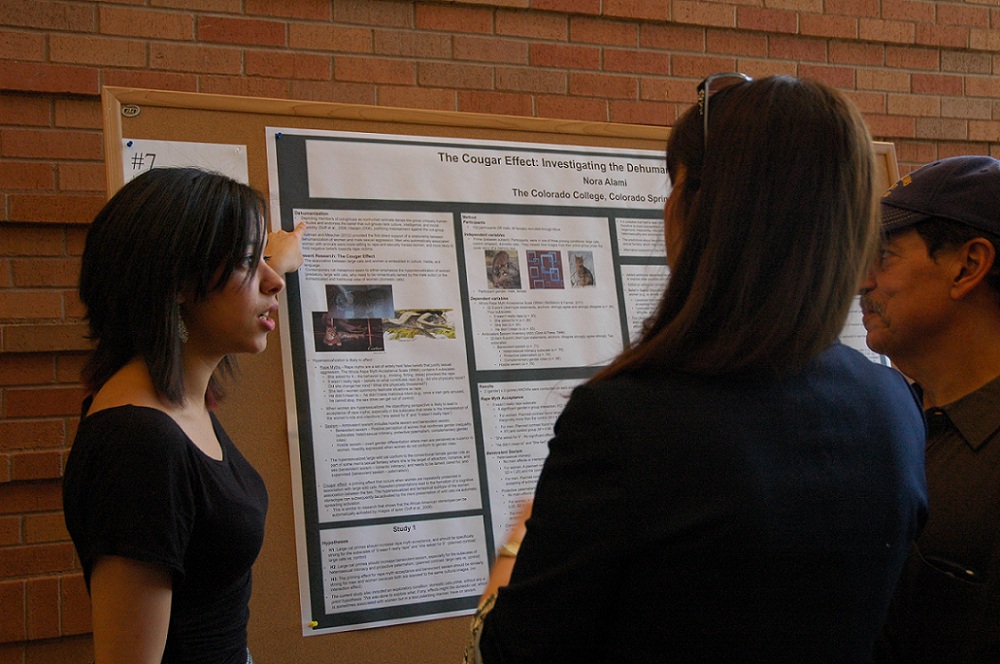
Psychology
Advisor: Emily Chan
The Cougar Effect: Investigating the Dehumanization of Women
The present research examines how dehumanization of gender may sustain gender inequality. Women are often depicted as or compared to wild cats (e.g., cougars, tigers). This explicit association was once historically prevalent and is still culturally embedded through the use of metaphor, stereotype, and the media. Though the association of women as large cats may seem harmless, the present research argues that this association is exemplary of dehumanization. Depicting humans as animal or less than human disrupts social cognition and maintains prejudice. The present research investigated whether supraliminal priming with images of large cats may have a relationship with the endorsement of sexist ideologies and rape myths. In studies 1 and 2, participants were either primed with images of large cats, a counter prime, or were shown images of geometric shapes. Both studies evaluated the impact of exposure to images of large cats on participant adherence to the Ambivalent Sexism Inventory and Illinois Rape Myth Acceptance Scale. Overall, the findings provided mixed support to the hypothesis that exposure to images of large cats have an effect on endorsement of sexist ideology. Results indicate that further research should more broadly investigate the relationship between women and large cats to better understand the nuanced implications of such an association.
Matthew Beck
Psychology
Advisor: John Horner
Review of Terror Management and Coalitional Conflicts: Potential for Compatibility
The two psychological theories, Terror Management Theory (TMT) and Coalitional Psychology (CP), debate the function of cultural worldview behavior. TMT posits that humans possess a unique and debilitating existential fear of death as a byproduct of increased intelligence. Psychological mechanisms called cultural worldview defenses manage the resulting anxiety. Cultural worldviews are ones values, such as religious strivings, community involvement, and close relationships, which function to imbue life with meaning, thereby allowing humans to cope with death anxiety and function when reminded of death. However, CP, born out of evolutionary thought, claims that TMT is not consistent with modern evolutionary theory and argues that some TMT research can be more parsimoniously explained as coalitional adaptations. Instead of dealing with death anxiety, worldview defense behavior instead facilitates group cohesion and identity formation. Stronger coalitional support is thought to have been adaptively advantageous for human ancestors. The two theories differ in regards to the theoretical nature of the adaptation underlying worldview defense behavior and their interpretations of empirical evidence related to the function of cultural worldviews. A possible relationship between the two theories is postulated. CP's claims put serious doubt on TMT's theoretical basis, but ultimately, CP does not have enough evidence supporting it to challenge TMT. Advice for future research to better understand the relationship between the two theories is discussed.
Elizabeth Leona Crow Burrus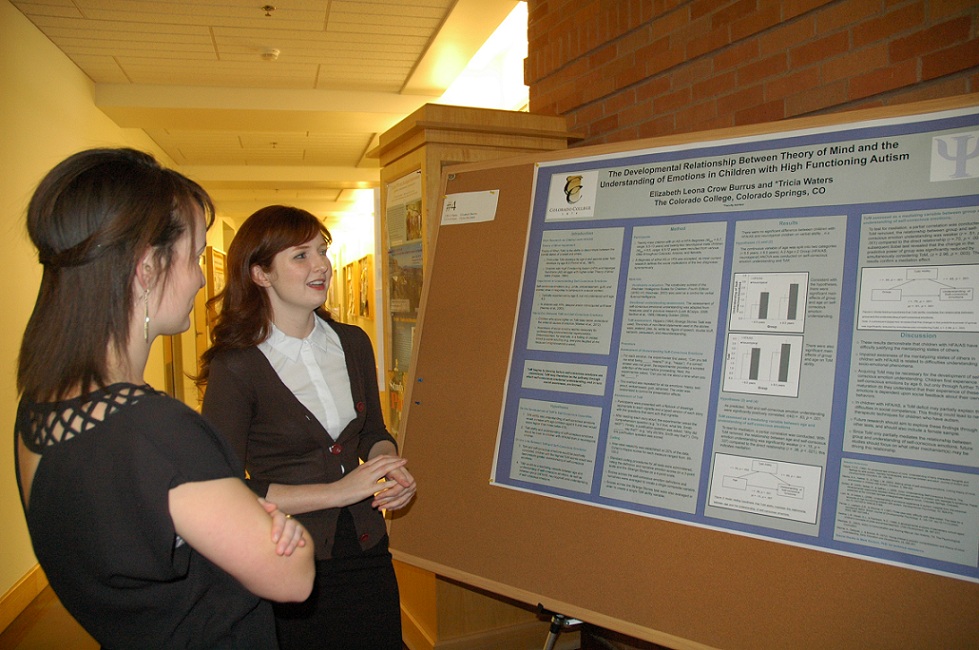
Psychology
Advisor: Tricia Waters
The Developmental Relationship Between Theory of Mind and the Understanding of Emotions in Children with High Functioning Autism
Theory of Mind (ToM) and the understanding of self-conscious emotions are impaired in children who have High Functioning Autism (HFA) and Asperger's Syndrome (AS) relative to typically developing (neurotypical) children. These impairments may account for some of the disparity between these groups in social competency. This study examined both capacities in neurotypical (N = 22) and HFA/AS (N = 20) male children between the ages of 6.5 and 13 years old. Participants defined both basic emotions (happy, sad) and complex emotions (pride, embarrassment, shame, guilt) and provided a personal narrative describing a time when they experienced each emotion. Participants also completed a modified version of the Strange Stories ToM Task (Happe, 1994). As predicted, ToM and understanding of self-conscious emotions were significantly lower in both the younger age group relative to the older age group and the HFA/AS group relative to neurotypical group. ToM mediated the relationship between group and age and the understanding of self-conscious emotions, suggesting that ToM may be a mechanism through which self-conscious emotions come to be understood. Implications of these findings for future research and treatment of the social deficits of HFA/AS children were discussed.
Elizabeth Dantzker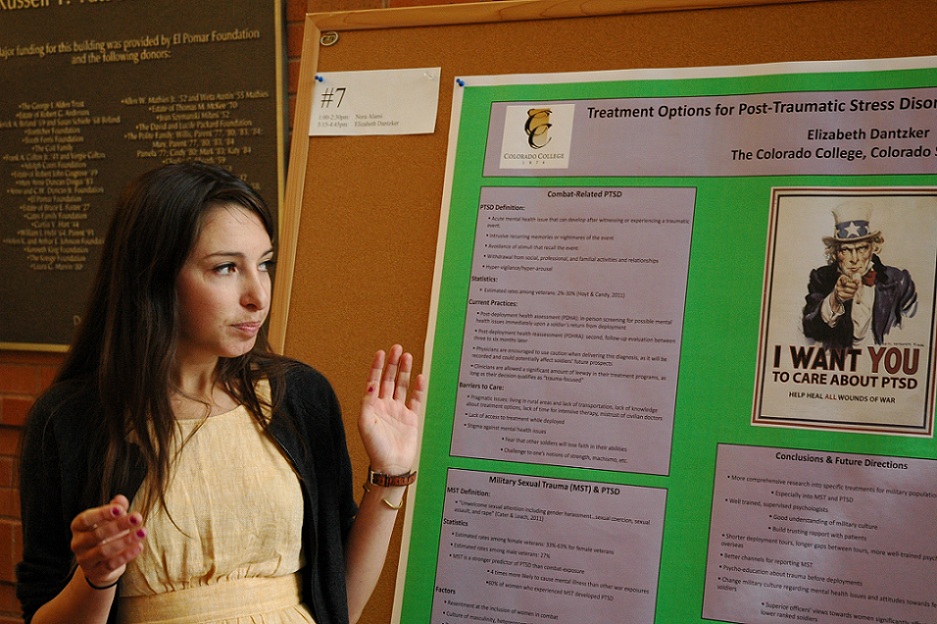
Psychology
Advisor: Kristi Erdal
Treatment Options for Post-Traumatic-Stress Disorder in the United States Military
Post-traumatic stress disorder (PTSD) is an anxiety disorder that has grown in public and academic interest as its rates within the veteran population rise. Characterized by intrusive recurring memories or nightmares of a traumatic event, avoidance of stimuli that recall the event, withdrawal from social, professional, and familial activities and relationships, and/or hyper-vigilance and hyper-arousal, PTSD affects an estimated 2-30% of US soldiers and veterans. Development of the disorder is usually caused by either combat exposure or military sexual trauma (MST) within the military population. This paper reviews the military's current policy regarding PTSD treatment as well as the treatments themselves, such as cognitive-processing therapies (CPT), imagery rehearsal therapies (IRT), exposure therapies (ET) and cognitive-behavioral therapies (CBT). By evaluating the successful aspects of each approach as they relate to combat- and MST-induced PTSD specifically, this paper suggests modifications to the different therapies that might increase their efficacy within this population. Institutional and cultural changes are also recommended to combat the stigma against PTSD and the reporting of MST.
Chelsea Davenport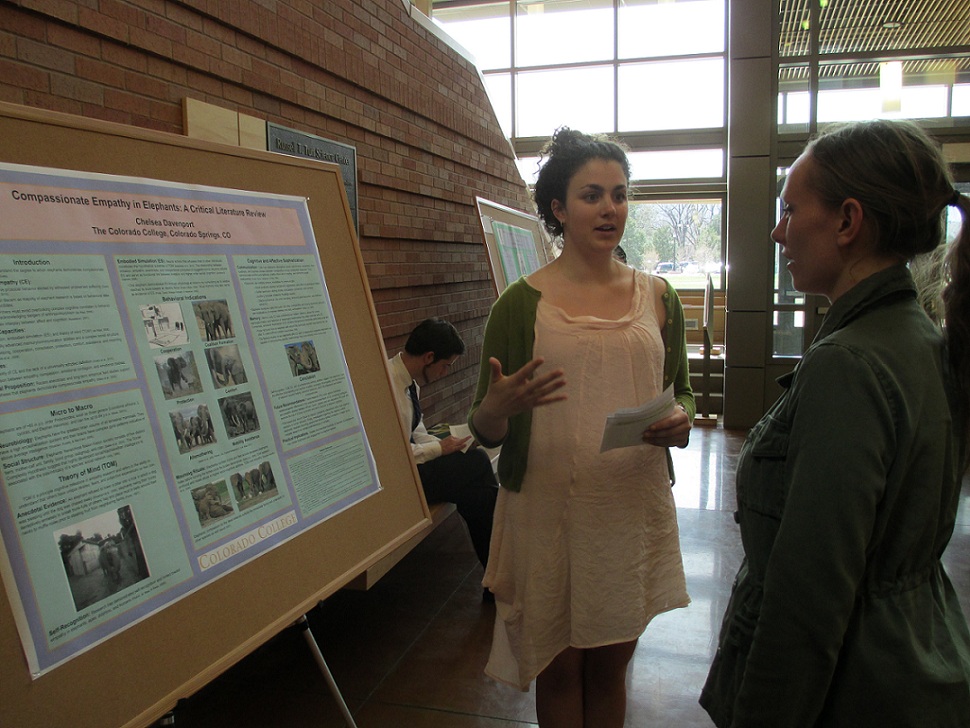
Psychology
Advisor: Bob Jacobs
Compassionate Empathy in Elephants: A Critical Literature Review
This review examines behavioral, neuroscientific, evolutionary, cognitive, and emotional research regarding compassionate empathy in elephants. Operationally defined as a shared affective state resulting in prosocial behavior and typically elicited by observed undeserved suffering, compassionate empathy is associated with specific appraisal patterns, display behaviors, phenomenological experiences, and physiological and neurological correlates (Goetz, Keltner, & Simon-Thomas, 2010). Animals that demonstrate the greatest behavioral manifestations of compassionate empathy tend to share the capacity for self-recognition, embodied simulation, and theory of mind (de Waal, 2006). Recent anecdotes and long-term empirical field studies suggest these qualities are present in elephant populations and support the hypothesis that elephants demonstrate compassionate empathy (Bates et al., 2008). The affective and cognitive capacities underlying compassionate and empathic elephant behaviors are vast yet difficult to measure empirically, as researchers must recognize the possibility of overlooking complex cognitive correlates to behavior while acknowledging the dangers of anthropomorphism. After considering previous studies and introducing novel interpretations, this review will discuss the limitations of current research and offer suggestions for further investigation.
Emily D. Epstein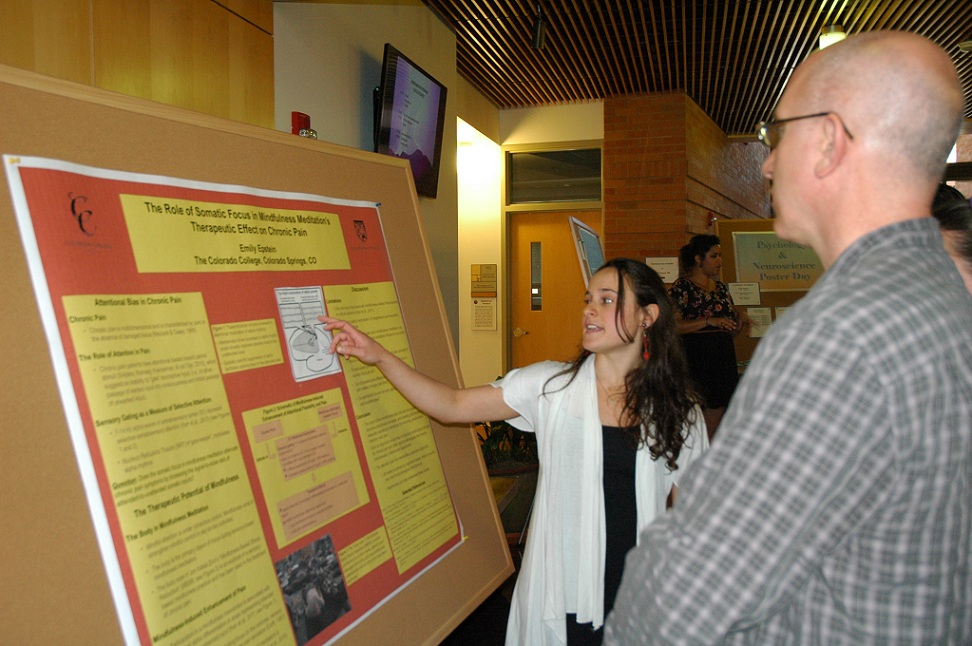
Neuroscience
Advisor: Bob Jacobs
The Role of Somatic Focus in Mindfulness Meditation's Therapeutic Effect on Chronic Pain
Chronic pain is a debilitating disorder in which pain persists in the absence of tissue damage. Mindfulness meditation has been used to treat chronic pain disorders with some success. Despite the importance of the somatic focus for mindfulness' effectiveness, current practices have stressed instead the role of cognitive reappraisal in ameliorating pain. Current research on cortical dynamics (CD), or activity-dependent electroencephalogram (EEG) brain waves, suggests the existence of a maladaptive deployment of anticipatory alpha rhythms as the basis for a maladaptive gating of painful stimuli among chronic pain patients. The present review analyzes mindfulness' mechanisms for treating chronic pain and argues that mindfulness may ameliorate chronic pain in part by increasing the signal-to-noise ratio of attended to unattended somatic stimuli. Further investigation into the role of somatic attention and its remediation through mindfulness training is warranted.
Alexander Glassman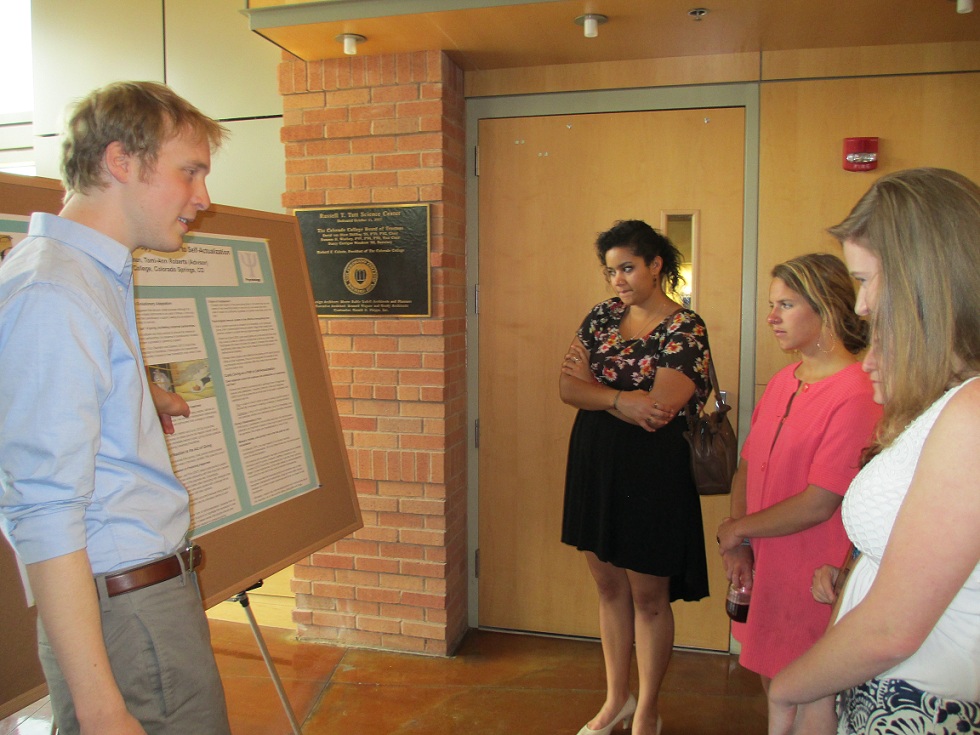
Psychology
Advisor: Tomi-Ann Roberts
The Gift of Giving: Philanthropy as a Path to Self-Actualization
Giving is generally understood as a personal sacrifice that benefactors endure for the good of society. However, a growing amount of research suggests that the relationship between givers and recipients is much more mutually beneficial than is generally believed. This paper examines literature that illustrates how incredibly rewarding giving can be, how this joy is distinct from other experiences such as compassion, and how giving is deeply rooted in the human psyche. The evolutionary basis for this phenomenon may be primarily based on Triver's (1971) conception of reciprocal altruism, which suggest that prosocial giving promotes reciprocal relationships which ultimately make both parties more evolutionarily fit. This paper then proceeds to use affective forecasting literature to draw conclusions about why we generally fail to predict that giving will be emotionally rewarding. Finally, and perhaps most importantly, the paper references literature which suggests that giving offers much more than a simple hedonic boost; it provides the opportunity for people to fulfill their desire to reach their full potential, to self-actualize.
Sarah Jacobson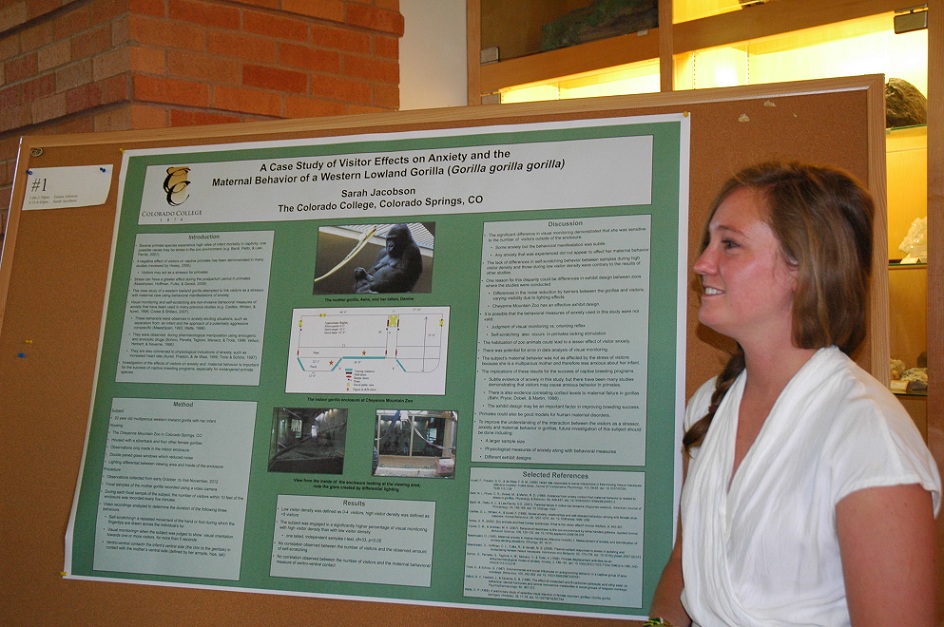
Neuroscience
Advisor: John Horner
A Case Study of Visitor Effects on Anxiety and Maternal Behavior of a Western Lowland Gorilla (Gorilla, gorilla, gorilla)
Captive primates are consistently exposed to human visitors, which has been demonstrated to have negative effects on their behavior. High numbers of visitors can be seen as a stressor for captive primates, and this stress is thought to contribute to an increase in anxiety. The endocrine and neuropeptide systems responsible for anxiety respond to stressors and work to maintain homeostasis in the nervous system. In the postpartum maternal period, these systems are adjusted for the stress of addressing an infant's needs, but may not be able to control additional external stress. The resulting anxiety in primate mothers may help account for maternal failure in the captive environment. To connect the evidence for visitor anxiety and poor maternal care, a case study was conducted of a mother western lowland gorilla (Gorilla gorilla gorilla) and her infant. Visual monitoring of visitors and self-scratching behaviors were used as measures of anxiety and changes were noted in ventro-ventral contact with the infant to establish quality of maternal care. The gorilla was viewed during periods of high and low visitor density to determine if there were any differences in these behaviors. Visual monitoring was determined to be significantly higher with high visitor density, but there were no significant differences in the other behaviors. This demonstrates that visitors had a slight effect on the mother's anxiety, but did not change her maternal behavior. Although these results indicate that visitor anxiety may not be as acute as previously hypothesized; further research may be needed to guarantee success of captive breeding programs especially with an endangered species such as the western lowland gorilla.
Emma K. Johnson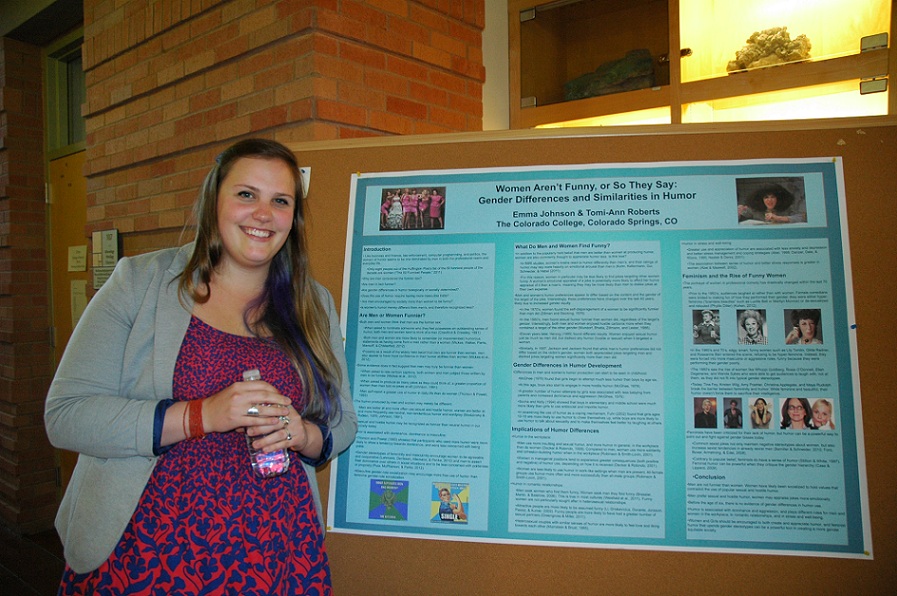
Psychology
Advisor: Tomi-Ann Roberts
Women Aren't Funny, or So They Say: Gender Differences and Similarities in Humor
Both popular culture and psychological research show that most people believe that men are funnier than women. This paper examines the validity of this stereotype by reviewing research on gender and humor production, appreciation, and the development and uses of humor in relationships, the workplace, and wellbeing. This research suggests a "separate but equal" model for understanding gender and humor. Men and women appreciate different kinds of humor and in turn use different kinds of humor. Sense of humor appears to develop differently for boys and girls, in sync with changes in gender roles and moral development. Humor tends to be associated with dominance and aggression and serves different purposes for men and women in both romantic relationships and the professional workplace. Importantly, both men and women appear to benefit in terms of stress-management and mental health from both the production and enjoyment of humor. A feminist framework helps reveal that the stereotype that women are not funny functions as a kind of sexism, undermining the benefits both genders deserve to reap from humor. Fortunately this attitude appears to be changing, as the rise of both famous funny women and feminist humor shows.
Nicholas L. Johnson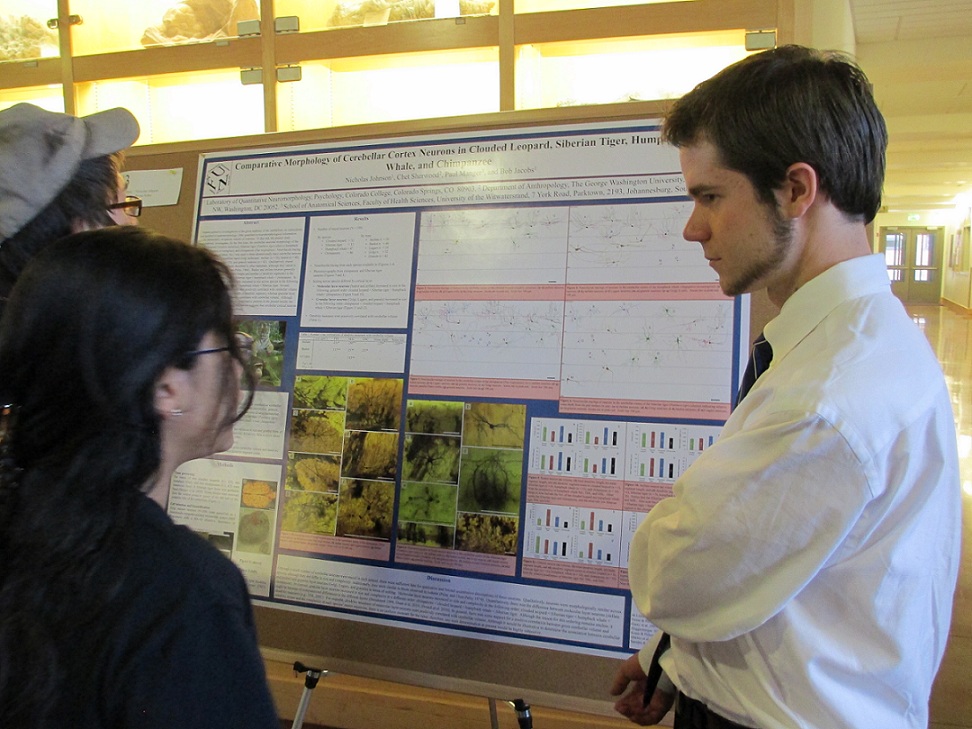
Neuroscience
Advisor: Bob Jacobs
Comparative Morphology of Cerebellar Cortex Neurons in Clouded Leopard, Siberian Tiger, Humpback Whale, and Chimpanzee
Despite extensive investigations of the gross anatomy of the cerebellum, its connections, and qualitative neuromorphology, little quantitative neuromorphological information exists, particularly on species outside of rodentia. To that end, the present study quantitatively investigates, for the first time, the cerebellar neuronal morphology of the clouded leopard (Neofelis nebulosa), Siberian tiger (Panthera tigris altaica) humpback whale (Megaptera novaengliae), and chimpanzee (Pan troglodytes). Neurolucida tracing software (MBF Bioscience, Inc.) was used to three-dimensionally trace cerebellar neurons (N = 198) stained by a modified rapid Golgi technique: stellate (n = 50), basket (n = 40), Golgi (n = 31), Lugaro (n = 35), and granule neurons (n = 42). Qualitatively, traced neurons appeared similar to those described in other mammals, although they varied in size across species (Palay & Chan-Palay, 1964). Basket and stellate neurons generally increased in size (e.g., total dendritic length and number of dendritic segments) in the following order: clouded leopard < Siberian tiger < humpback whale < chimpanzee. In contrast, Golgi, Lugaro, and granule cells increased in size across species in the following order: chimpanzee < clouded leopard < humpback whale < Siberian tiger. Several molecular layer neuronal measures were also positively correlated with cerebellar volume (e.g., total dendritic length, average length of dendritic segment), whereas granular layer neuronal measures were not significantly correlated with cerebellar volume. Although there were no consistent species-specific quantitative patterns in the present results, the basic morphology of neurons in examined species suggests that cerebellar cortical neurons are evolutionarily conserved within mammals.
Diane Sharp Kelly
Neuroscience
Advisor: Lori Driscoll
The Effects of PBDEs on Rat Social Interaction
Polybrominated diphenyl ethers (PBDEs) are persistent organic pollutants that bioaccumulate in organisms and the environment. Exposure to PBDEs during development has been shown to impair learning and attention in animal models and has been correlated to abnormal behavior in humans. Hypothyroidism is a major side effect of PBDE exposure and is hypothesized to be a strong contributor to its toxicity. The present study exposed rats during the brain growth period to the commercial PBDE mixture DE-71, and is the first to investigate the behavioral effects of PBDE exposure using a rat social interaction test. Treatments were administered during postnatal days 6-12 and the five treatment groups included in the study were low (30mg/kg body weight/day) and high (60mg/kg body weight/day) dose DE-71, low (30mg/kg body weight/day) and high (60mg/kg body weight/day) dose DE-71 plus levothyroxine supplement (6mg/kg body weight/day LT4), and control (corn oil). Pair interactions were recorded and analyzed for frequencies of crossovers and rearing, and durations of aggression, self-grooming, and play-fighting. No main effect of treatment group was found, but weight differences had a significant effect on all measures and age had a significant effect on all behaviors except rearing. Future studies should investigate the potential of LT4 to prevent PBDE induced hypothyroidism and the long-term behavioral effects of perinatal exposure in humans.
Alexis Dale Kleiman
Psychology
Advisor: Lori Driscoll
Effects of DE-71 Exposure on Spatial Learning, Reference Memory, and Relearning Ability in Rats: Mitigation by Thyroid Hormone Supplementation
Polybrominated diphenyl ethers (PBDEs) are a class of flame retardant used as a chemical additive in many household products. PBDEs are not chemically bound to their polymer products, so they leak into the environment and eventually bioaccumulate in both humans and animals. The present study investigated the effects of developmental exposure to the commercial PBDE mixture DE-71 on spatial learning, memory, and reversal learning in the adult rat. These effects are hypothesized to be due, in part, to DE-71-induced hypothyroidism, which can delay brain development. Rats were orally administered DE-71 (60 or 30 mg/kg body weight/day) dissolved in corn oil on postnatal days 6-12; the control rats received corn oil alone. Half of the DE-71 exposed rats were also orally administered 6 µg/kg/day of levothyroxine (LT4) on postnatal days 6-12 in an attempt to ameliorate the effects of DE-71. Spatial learning, reference memory, and relearning ability were assessed at 3 months of age and then again at 5 months of age using the Morris water maze. No effect of DE-71 was found on learning or reference memory on the visible platform task or the hidden platform task. However, treatment effects were found on the reversal task in the older rats. In addition, LT4 had an ameliorative effect on DE-71 exposure for reversal learning in the older cohort. Future studies should continue to examine the types of deficits DE-71 exposure causes as well as the regions of the brain that are most vulnerable. Thyroid hormone should be further studied as a potential therapeutic agent in infants who are exposed to high levels of PBDEs.
Laura Lee
Neuroscience
Advisor: Bob Jacobs
Neocortical neuronal morphology in the infant giraffe (Giraffa camelopardalis tippelskirchi) and infant African elephant (Loxodonta africana)
Although neocortical neuronal morphology has been recently documented in the adult African elephant (Loxodonta africana; Jacobs et al., 2011) and giraffe (Giraffa camelopardalis tippelskirchi; Jacobs et al., submitted), nothing is known about cortical architecture in the infants of these species. Thus, the current study explores motor and visual cortices in the infant giraffe, and frontal, motor, and visual cortices in the infant elephant. Cortical neurons stained with a modified Golgi technique (N = 153) were quantified on a Neurolucida computer-assisted microscopy system (MBF Bioscience), which allowed examination of both dendritic and spine systems. Qualitatively, neurons in the infant giraffe appeared similar to those in adult giraffes and were consistent with those observed in (murid) rodent and (anthropoid) primate species. In contrast, neurons in the infant elephant, like those in adult elephants, varied greatly from the "typical" pyramidal morphology usually found in the neocortex of other placental mammals (i.e., rodent or primate). In general, projection neurons were observed in both species (i.e., pyramidal neurons, n = 46; magnopyramidal neurons, n = 5; horizontal pyramidal neurons, n = 5), with a much greater variety documented in the elephant (e.g., flattened pyramidal neurons, n = 10; multipolar neurons, n = 18; inverted pyramidal neurons, n = 3; crab-like neuron, n = 1). Although local circuit neurons in both species (i.e., interneurons, n = 40; neurogliaform neurons, n = 4) resembled those observed in other eutherian mammals, these were usually spiny, which contrasts with their adult, aspiny-equivalents. Quantitatively, infant elephant neurons were less spiny but had longer dendritic branches than those in the giraffe, perhaps because of widely diverging apical dendrites in elephant projection neurons. In a comparison to the adults of these species, infant projection neurons were much smaller in both species, but infant interneurons tended to be larger than their adult counterparts. In conclusion, cortical neuromorphology in the infant giraffe is generally consistent with what has been observed in other cetartiodactyls, whereas infant and adult elephant morphology appears to deviate considerably from what is commonly observed in other mammals.
Lindsay MacCary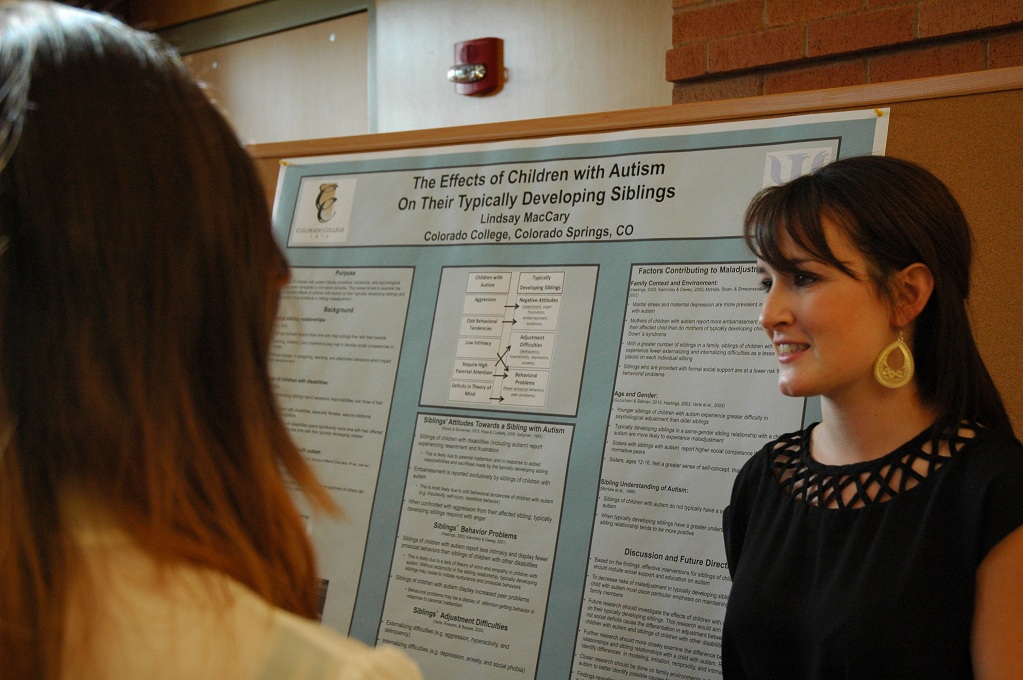
Psychology
Advisor: Tricia Waters
The Effects of Children with Autism on Their Typically Developing Siblings
The objective of the present review is to identify the effects of children with autism on the attitudes, behaviors, and psychological adjustment of typically developing siblings. Behavioral and cognitive characteristics of individuals with autism, including aggression, repetitive behavior, and social deficits may lead to anger and resentment in their typically developing siblings. Siblings of children with autism are more likely to experience behavioral problems than their peers with their typically developing siblings. Also among the findings, siblings of children with autism are found to be at a greater risk for anxiety, depression, and other affective disorders. Shifts in the family dynamic, which occur in families with a child with autism, can greatly impact the psychological well-being of siblings of children with autism. With a focus on a family systems framework, this paper unveils the impacts of children with autism on their typically developing siblings, along with the factors which may contribute to maladjustment in typically developing siblings.
Victoria Marsh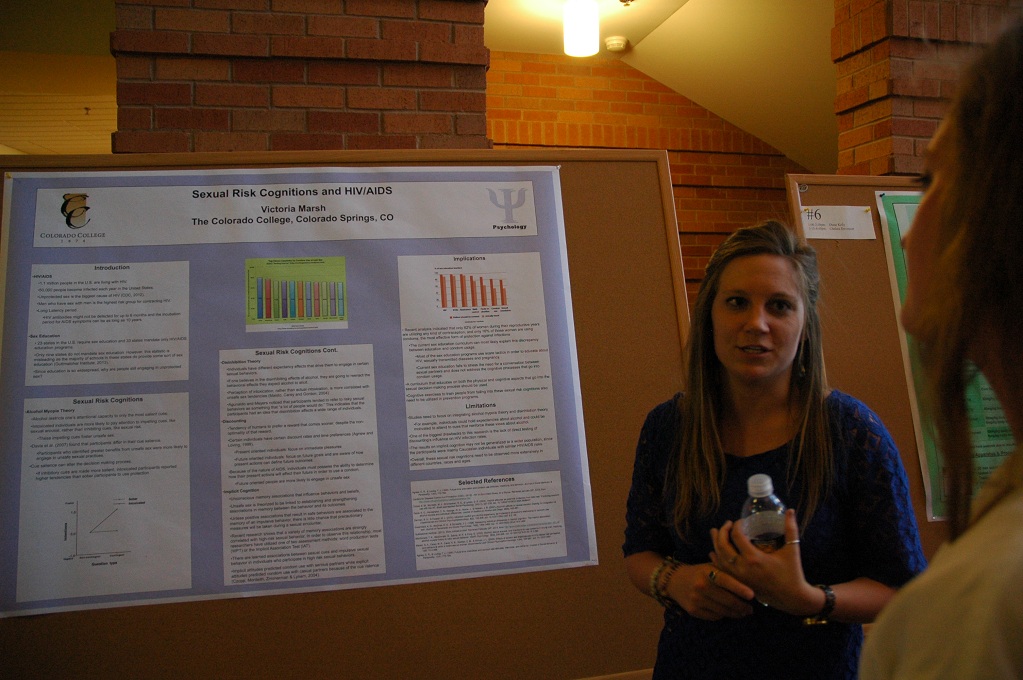
Psychology
Advisor: John Horner
HIV and Sexual Risk Cognitions
This paper reviews cognitive based predictors of HIV risk behavior. Findings from experiments examining sexual risk cognitions yielded three main mechanisms that drive unsafe sexual behaviors. Overall, it was observed that alcohol effects, discounting tendencies and implicit cognition all impact the sexual decision making process to some degree and cause individuals to engage in unsafe sexual behaviors. Methodological limitations and future implications are also discussed. Although the research examined in this paper does have drawbacks, HIV/AIDS education and prevention programs can utilize this research in order to lower unsafe sex tendencies and HIV/AIDS infection rates.
Flynn McGuire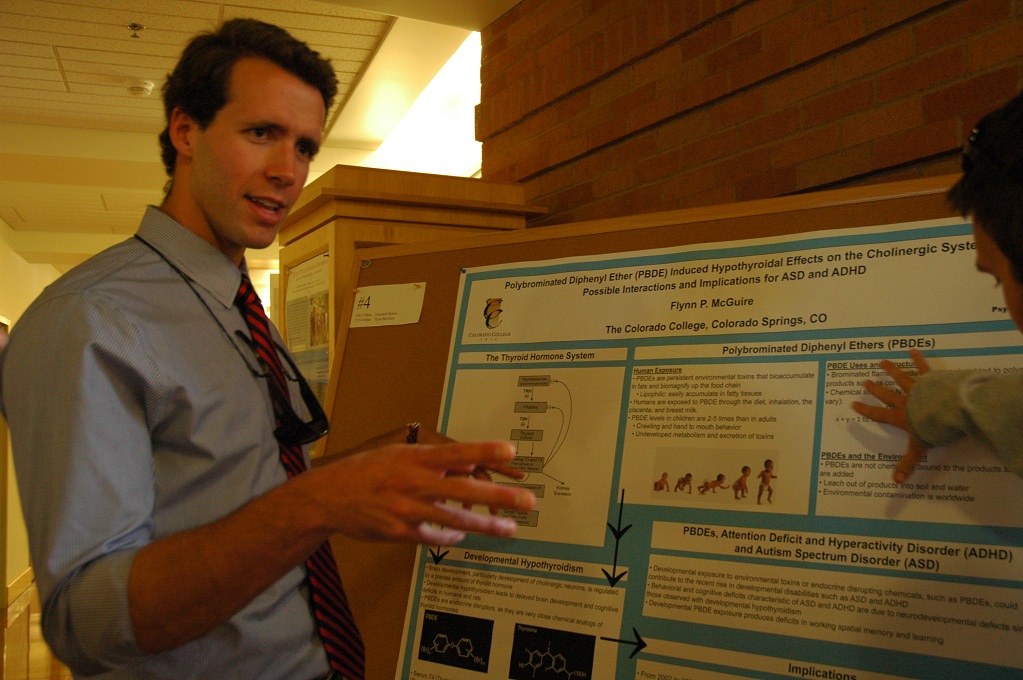
Neuroscience
Advisor: Lori Driscoll
Polybrominated Diphenyl Ether Induced Hypothyroidal Effects on the Cholinergic System: Possible Interactions and Implications for ASD and ADHD
Levels of brominated flame retardants such as polybrominated diphenyl ethers (PBDEs) have been increasing in usage since their introduction into common production in the 1970s. PBDEs have become ubiquitous in the environment and bioaccumulate and magnify up the food chain with high levels found in indoor air, household dust, food, and animal and human tissues. Especially in the past 10 years, diagnoses of Autism Spectrum Disorder (ASD) and Attention Deficit Hyperactivity Disorder (ADHD) have risen in a parallel timeframe as PBDEs. Though it remains difficult to associate causalitybetween PBDE exposure and specific disorders such as ASD or ADHD, there is ample evidence to justify that PBDEs may affect development of important neurotransmitter systems such as the cholinergic system through modulation of thethyroid hormone system. This review provides a synthesis of information about the environmental distribution of PBDEs, how the thyroid hormones regulate development of the CNS and cholinergic system, and in what modalities PBDE induced hypothyroidism could affect brain development and the implications for ASD and ADHD.
Melissa Melamud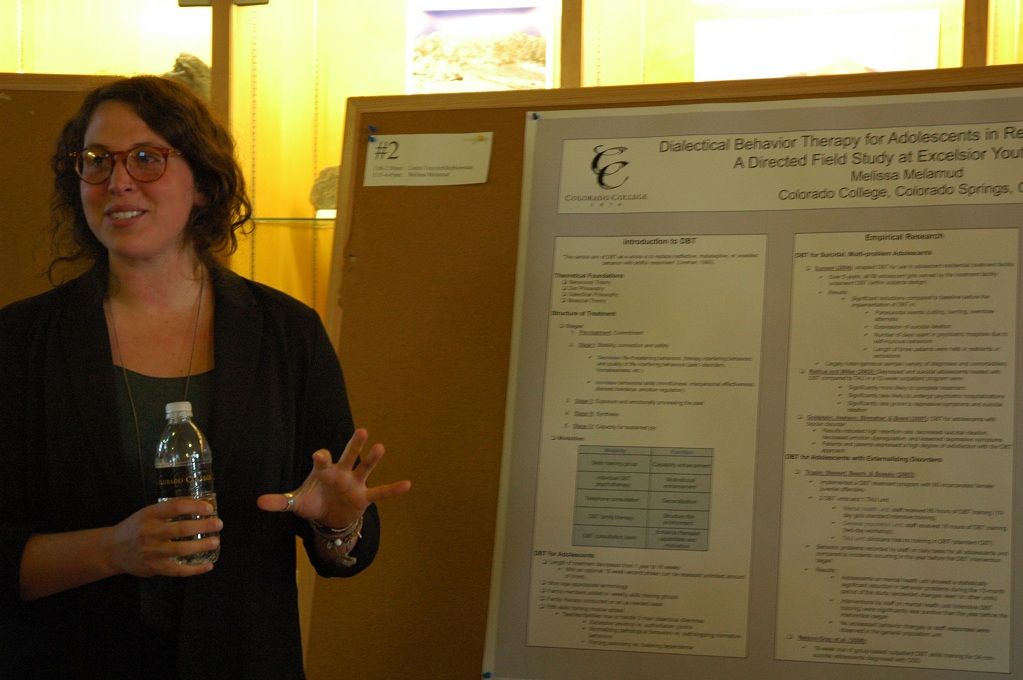
Psychology
Advisor: Tricia Waters
Dialectical Behavior Therapy for Adolescents in Residential Treatment: A Directed Field Study at Excelsior Youth Center
Dialectical Behavior Therapy (DBT) was first developed by Marsha Linehan in 1993 to treat chronically suicidal adult women with borderline personality disorder (BPD). With proof of efficacy in the first randomized controlled trial (Linehan, Armstrong, Suarez, Allmon, & Heard, 1991), other researchers took notice and began to adapt and apply DBT for other difficult-to-treat patients. This paper recounts the history, philosophical/ theoretical background and structure of DBT. It then gives an account of empirical evidence that supports the use of DBT for adolescents in residential treatment. Ultimately, I relate the literature to my field experience at Excelsior Youth Center (a residential treatment facility for adolescent girls) and identify the gaps between the literature and the real world such as inadequate staff training and lack of DBT implementation at a facility where research would imply great success with DBT.
Alexandra Jane Regas-Riewerts
Psychology
Advisor: Kristi Erdal
The Criminal Legal System as it Pertains to the Insanity Defense Process
Research concerning NGRI and conditional release of insanity acquittees is continually expanding to account for the widespread controversy over the policy and practice of reintegrating acquittees into the community. This paper examines research on the history of the insanity defense, highlighting public attitudes, alternatives to the defense, and discrepancies among different jurisdictions. Mental health experts and the general public appear to have an influential role within the court system. Studies that were reviewed in order to determine the factors related to receiving an NGRI acquittal and obtaining and maintaining conditional release, revealed that personal characteristics, diagnostic history, criminal history, and aftercare of NGRI patients are influential in the insanity defense process. Individual-level characteristics appeared to serve as significant predictors of both achieving an NGRI acquittal and obtaining and maintaining conditional release. Diagnosis of substance abuse and previous criminal history were predictive of both initial violent behavior and revocation of conditional release . The studies reviewed in this paper imply that with adequate treatment and reformed policies regarding risk assessment and evaluation, outpatient treatment can be successful for the patient and safe for the community. Early preventative measures that may reduce the co-occurrence of mental illness and criminal behavior are considered.
Brynn Schor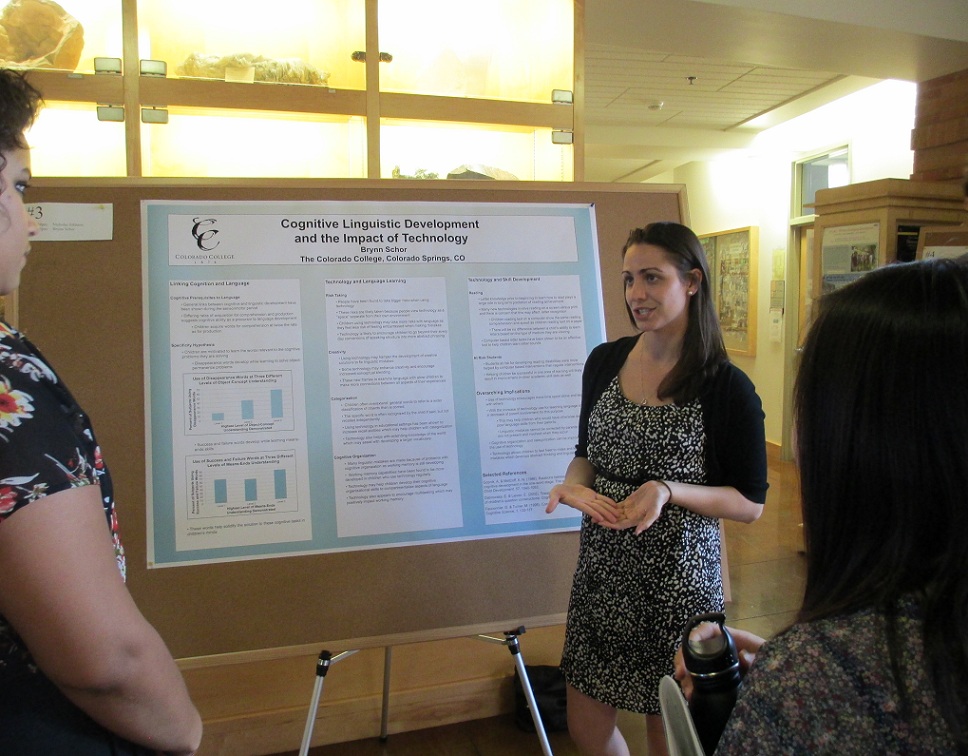
Psychology
Advisor: Bob Jacobs
Cognitive Linguistic Development and the Impact of Technology
As society continues to increasingly incorporate technology in day to day use, the effect this influx has on cognitive linguistic development is examined. After examining the acquisition of language as well as common mistakes made during the development of this ability, the effect current technology use has on this process is inferred. Further, the effect technology has on other skill areas related to language is surmised. Use of technology appears to offer mostly positive benefits in regard to children's cognitive linguistic development and likely serves to help children overcome embarrassment of making mistakes when learning language as well as organize categories, vocabulary, and grammar rules. Further, the use of technology in homes and classrooms may encourage proper linguistic development which will help with a variety of academic skills long term.
Trevor Shepard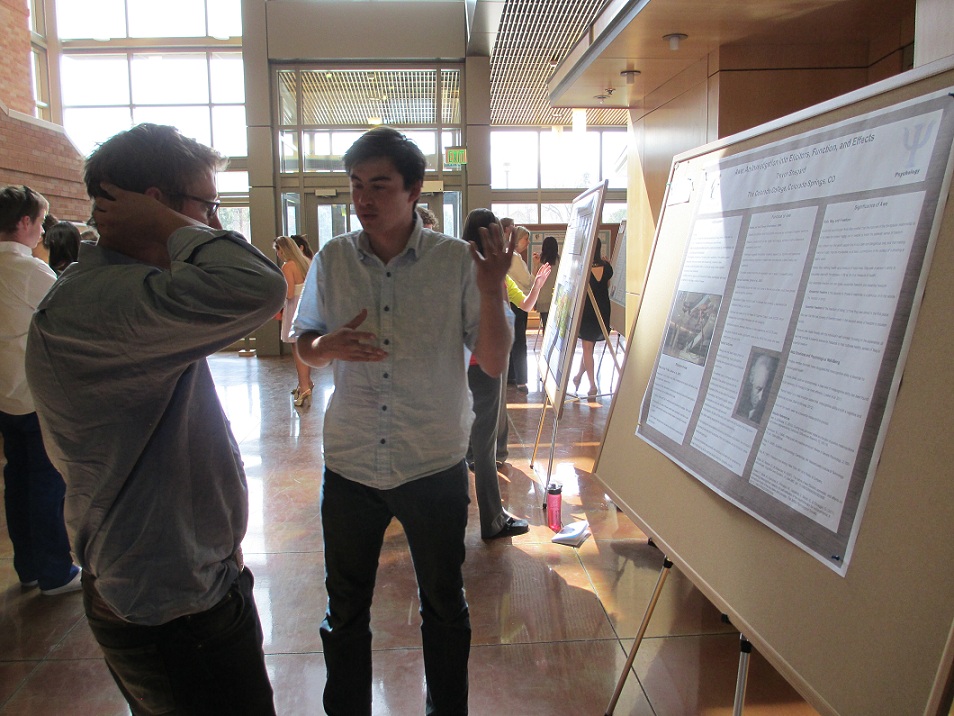
Psychology
Advisor: Tomi-Ann Roberts
Awe: An Investigation into Elicitors, Functions, and Effects
This paper reviewed the literature on the under-studied emotional experience of awe, and suggests that awe is a distinct emotion with important implications for human thriving and psychotherapy. The limited psychological research on the emotion of awe has identified it as a distinct emotion elicited by experiences appraised as vast in scope and yielding a greater openness in individuals. Philosophical perspectives regarding Immanuel Kant's aesthetics of the sublime support this idea that awe is experienced in the face of large ideas, and also suggest that awe has a profound effect on individuals' cognitive structures - opening them to new possibilities. Extrapolating from research into meta-emotions as well as ideas proposed by existential psychologist Rollo May, this paper argues that awe may provide a powerful tool for promoting psychological well-being.
Benjamin Cooper Taymore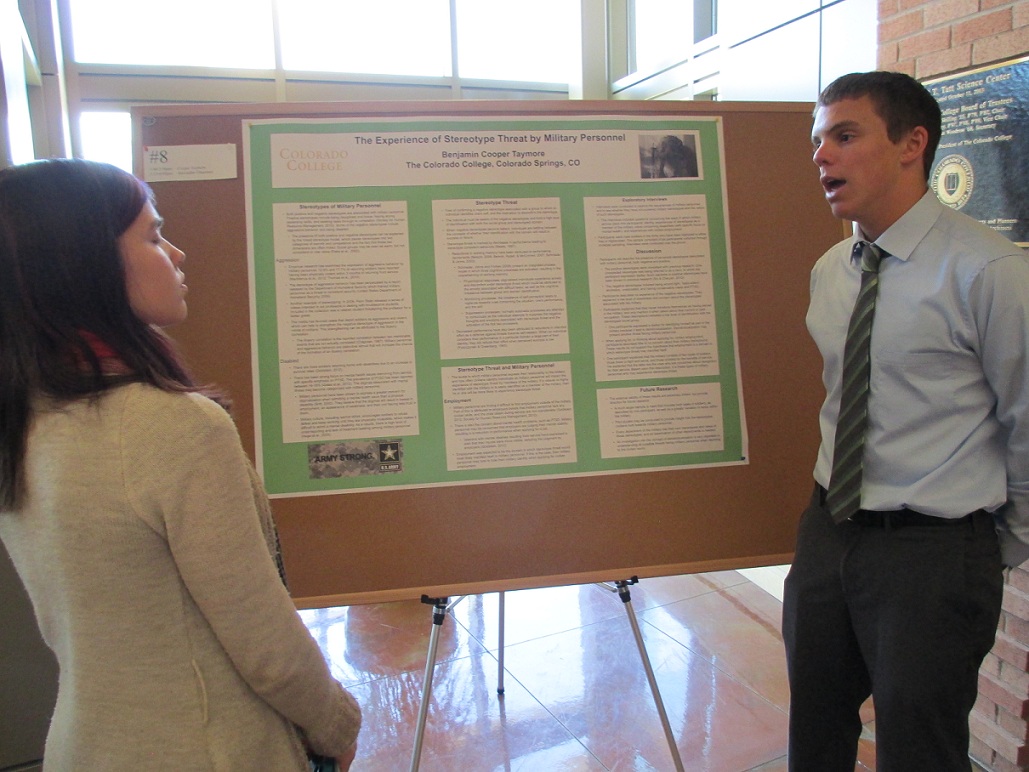
Psychology
Advisor: Emily Chan
The Experience of Stereotype Threat by Military Personnel
This literature review examined the negative stereotypes of aggressive behavior and disabilities that military personnel may face in the civilian world. Based upon the presence of a negative stereotype, speculation was made concerning the experience of stereotype threat. Military personnel were predicted to experience stereotype threat as a result of their high level of identification with the military. Military personnel were also expected to experience stereotype threat while applying for civilian employment. Six interviews were conducted with male members of the Army who had served in Iraq and/or Afghanistan. The interviews supported the presence of the proposed negative stereotypes, as well as providing additional stereotypes associated with military personnel. Participants reported a low level of identification with their military service and a lack of consideration for stereotypes associated with military personnel. The interviews indicated a low likelihood of stereotype threat experience by members of the military. This research discussed areas that should be explored in relationship to the experience of negative stereotypes by military personnel.
Laura Touysinhthiphonexay
Psychology
Advisor: Tricia Waters
The Interpersonal Relationships of Homeless Youth: Beneficial and Detrimental Effects on Well-Being
Each year, millions of youth in the United States experience youth homelessness, a situation with several unique characteristics distinguishing it from general adult homelessness. Homeless youth are often too young or distrustful of institutions to access ordinary services available to homeless individuals. They are also at greater risk of becoming permanently homeless than are their adult counterparts. Relationship formation and maintenance are essential to the survival of homeless youth. Relationships provide youth with emotional support and social benefits as well as physical support such as shelter and financial resources. Due to these substantial differences from the adult homeless population, special attention must be given to intervention efforts aimed at removing homeless youth from the street. This paper reviews the literature surrounding the various types of interpersonal relationships that are common to homeless youth as well as the benefits and detriments they offer. It also reveals the strength of peer relationships of homeless youth and the potential efficacy of intervention methods incorporating that bond.
Rebecca Twombly
Neuroscience
Advisor: Lori Driscoll
The Effect of the Polybrominated Diphenyl Ether Mixture DE-71 on Perceptual Attentional Set Shifting in Rats
Polybrominated diphenyl ethers (PBDEs) are commonly utilized flame-retardants. They are readily released into the environment, bioaccumulate in fatty tissues, and biomagnify up food chains. PBDEs are endocrine disruptors, which decrease circulating levels of thyroxine (T4) and inducing hypothyroidism in exposed animals. Perinatal exposure of rats to PBDEs is correlated to deficits in learning and attention, as well as abnormal motor behavior in adulthood. In the current experiment, rats were exposed to the PBDE mixture DE-71 (0, 30, or 60 mg/kg body weight/day dissolved in corn oil) from postnatal days 6-12, and then prefrontal cortical (PFC) function was assessed using a series of perceptual attentional set shifting tasks. The DE-71 exposed rats performed worse than the non-exposed rats on the reversal tasks, particularly the first reversal. Rescue doses of levothyroxine (LT4; 6 mg/kg/day) partially mitigated these deficits. Female rats appeared to be more impaired by DE-71 than male rats, with the 60 mg/kg/day females, demonstrating marked motivational impairments in the face of reversed contingencies. The specific patterns on the reversal tasks suggest that the orbitofrontal cortex (OFC) is particularly sensitive to the effects of developmental PBDE exposure.
Maia A. Wynn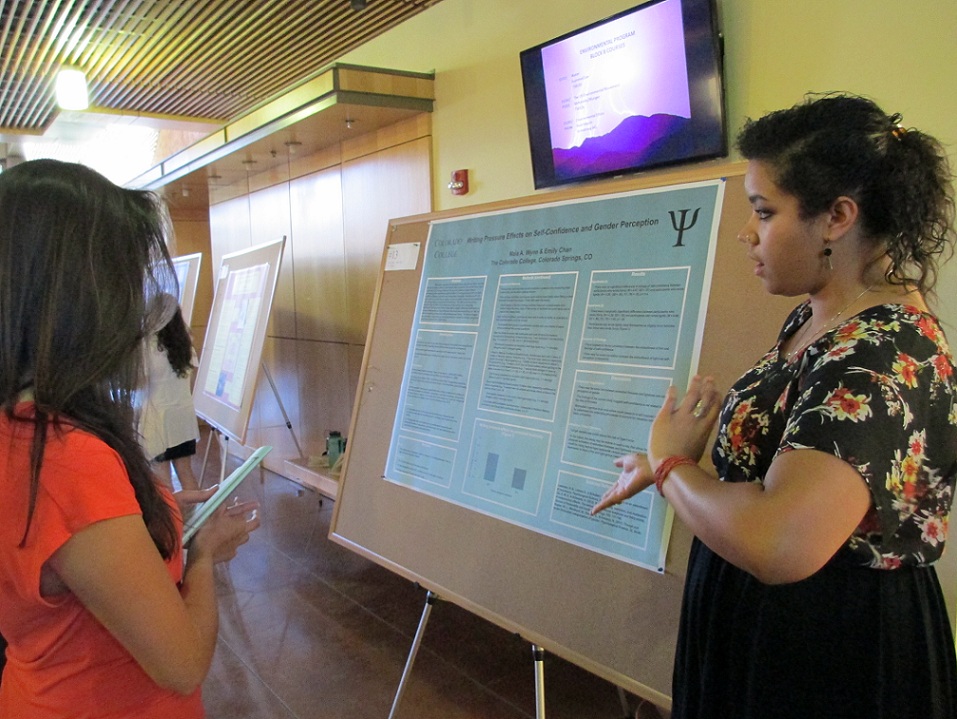
Psychology
Advisor: Emily Chan
Writing Pressure Effects on Self-Confidence and Gender Perception
Embodied cognition is a growing field in psychology which explores the way in which sensory experiences effect human cognition. The current study was a 2x2 between subject design investigating the embodied cognition effects of gender and writing pressure (firm vs. light) on self-confidence and self-rated masculinity/ femininity. Participants (n = 83) were asked to write firmly or lightly on a survey which measured self-confidence and self-perceived masculinity and femininity. The data found that writing pressure had no effect on perceptions of masculinity, but a marginally significant finding showed that writing lightly slightly influenced participants to perceive themselves as more feminine than those who wrote firmly (p = .06). No effects of writing pressure and/or gender on self-confidence were found. The results suggest that past work supporting an embodied effect on confidence ratings and gender perception needs further exploration.
show all / hide all


